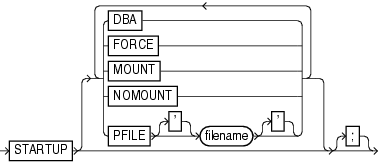| Oracle® Database Backup and Recovery Reference 11g Release 2 (11.2) Part Number E10643-01 |
|
|
View PDF |
| Oracle® Database Backup and Recovery Reference 11g Release 2 (11.2) Part Number E10643-01 |
|
|
View PDF |
Purpose
Use the STARTUP command to start the target database from within the RMAN environment. This command is equivalent to using the SQL*Plus STARTUP command.
Additionally, the RMAN STARTUP command can start an instance in NOMOUNT mode even if no server parameter file or initialization parameter file exists. This feature is useful when you need to restore a lost server parameter file.
See Also:
Oracle Database Administrator's Guide to learn how to start up and shut down a database, and SQL*Plus User's Guide and Reference for SQL*PlusSTARTUP syntaxPrerequisites
RMAN must be connected to a target database. You can only use this command to start the target database.
Usage Notes
The RMAN STARTUP command can start an instance in NOMOUNT mode even if no server parameter file or initialization parameter file exists. This feature is useful when you need to restore a lost server parameter file (see Example 3-54).
Syntax
startup::=

Semantics
| Syntax Element | Description |
|---|---|
STARTUP |
If you specify only STARTUP with no other options, then the instance starts the instance with the default server parameter file, mounts the control file, and opens the database. |
DBA |
Restricts access to users with the RESTRICTED SESSION privilege. |
FORCE |
If the database is open, then FORCE shuts down the database with a SHUTDOWN ABORT statement before re-opening it. If the database is closed, then FORCE opens the database. |
MOUNT |
Starts the instance, then mounts the database without opening it |
NOMOUNT |
Starts the instance without mounting the database. If no parameter file exists, then RMAN starts the instance with a temporary parameter file. You can then run RESTORE SPFILE to restore a backup server parameter file. |
PFILE filename |
Specifies the filename of the text-based initialization parameter file for the target database. If PFILE is not specified, then the default initialization parameter filename is used. |
Example 3-53 Mounting the Database While Specifying the Parameter File
This example forces a SHUTDOWN ABORT and then mounts the database with restricted access, specifying a nondefault initialization parameter file location:
CONNECT TARGET / STARTUP FORCE MOUNT DBA PFILE=/tmp/initPROD.ora;
Example 3-54 Starting an Instance Without a Parameter File
Assume that the server parameter file was accidentally deleted from the file system. The following example starts an instance without using a parameter file, then runs RESTORE SPFILE FROM AUTOBACKUP. In this example, the autobackup location is the fast recovery area, so SET DBID is not necessary.
CONNECT TARGET / STARTUP FORCE NOMOUNT; # RMAN starts instance with dummy parameter file RESTORE SPFILE TO '?/dbs/spfileprod.ora' FROM AUTOBACKUP RECOVERY AREA '/disk2' DB_NAME='prod'; STARTUP FORCE; # restart instance with restored server parameter file